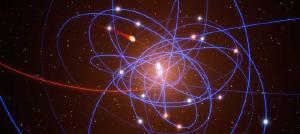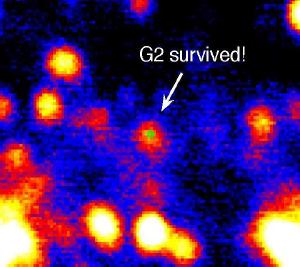Blog
Holding It Together
6 November 2014
 European Southern Observatory
European Southern ObservatoryIn the center of our Milky Way galaxy is a supermassive black hole. We can’t see this black hole directly because there is too much dust in the direction of galactic center, but radio waves can penetrate that dust, so we can observe the radio signals of hot stars and gas near galactic center. We’ve been observing these signals over several years, and we’ve noticed how the stars near galactic center orbit the region very quickly. From their orbital motion and a simple use of Kepler’s laws we can get a pretty good idea of the mass of the black hole. It turns out to be about 4 million solar masses. While this is a huge black hole, most of the stars orbiting it aren’t too terribly close. So for the time being they aren’t at risk of being ripped apart by the intense forces near the black hole. But there was one object recently that did make a very close approach.
This particular object is known as G2. First discovered in 2012, its projected orbit would take it within 36 light hours of the black hole at closest approach, which is only about 1,500 times the diameter of the black hole itself. At this distance the tidal forces of the black hole would likely rip G2 apart. This caused a great deal of excitement, since we’ve never seen a black hole destroy an object. Initial studies of G2 seemed to imply that it was a gas cloud of about three Earth masses. It was difficult to be sure because we can only really see it by radio wave emissions. Such a cloud would easily be ripped apart by the black hole, so studies focused on observing the process in action. Even early on we could see that the cloud was being disrupted as it approached the black hole.
 UCLA Galactic Center Group
UCLA Galactic Center GroupBut this Summer when the object made its closest approach, it didn’t rip apart. The latest observations, as published this month in the Astrophysical Journal, have shown that G2 remains intact.1 This is not only surprising, it means that G2 is nothing like what we thought. A diffuse gas cloud would have been ripped apart, so G2 can’t be diffuse. From the latest observations it seems to be a bright star surrounded by a thick region of dust.
So how could we have been so wrong about G2? Part of it could be due to the thick layers of dust around the star itself, but at radio frequencies the dust shouldn’t affect the brightness too much. So the authors propose another solution. Perhaps G2 has been a close binary star, and these stars have recently merged into a larger and brighter star. The close orbit of G2 with the black hole could even have accelerated the merger process, through something known as the Kozai mechanism. If G2 is a recent merger, that would explain both the level of dust around the star as well as a dimmer than expected appearance.
So rather than ripping G2 apart, the supermassive black hole in our galaxy may have worked to hold G2 together.
Witzel, Gunther, et al. “Detection of galactic center source G2 at 3.8 μm during periapse passage.” The Astrophysical Journal Letters 796.1 (2014): L8. ↩︎